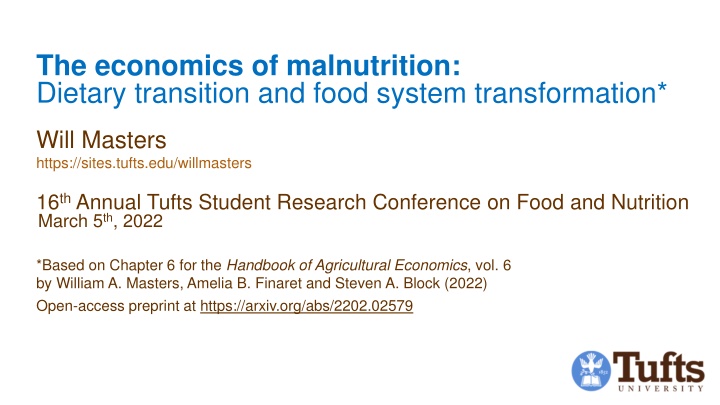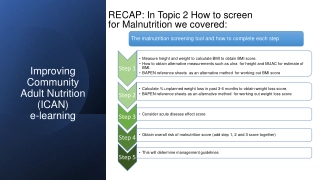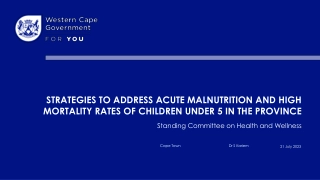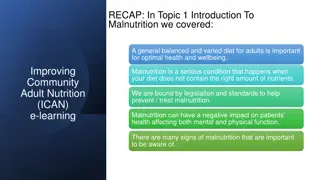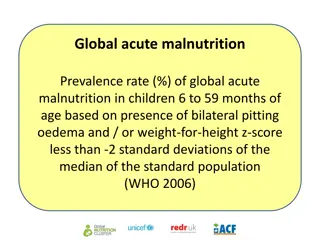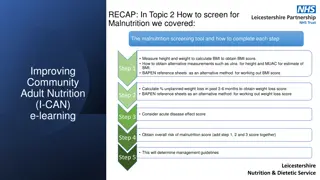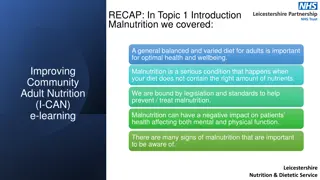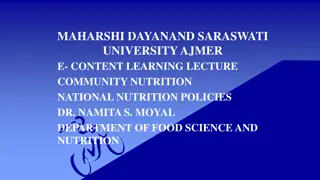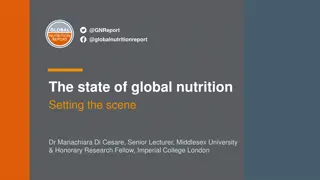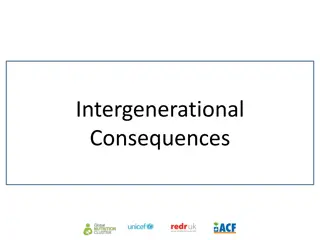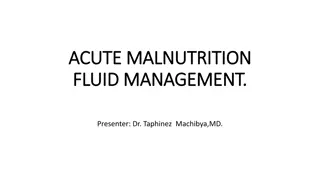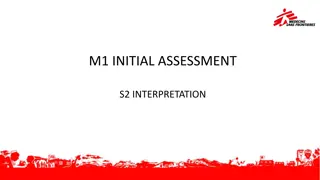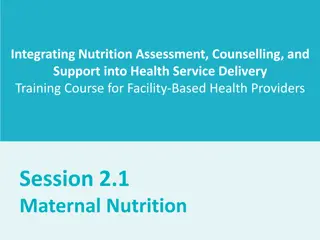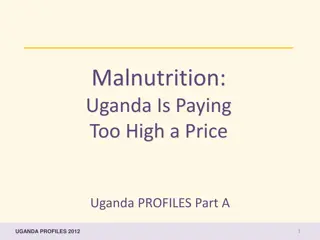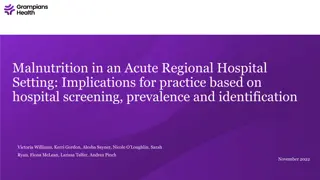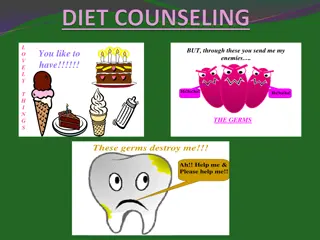The Economics of Malnutrition: Dietary Transition and Food System Transformation
This research delves into the various aspects of malnutrition, from the consequences of dietary intake to understanding malnutrition in its different forms, including the double and triple burdens. It explores the global tracking of malnutrition by organizations like the FAO and introduces new metrics like the Prevalence of Undernourishment and Food Insecurity. The study also discusses the unaffordability of a healthy diet and how the food environment contributes to malnutrition.
Download Presentation

Please find below an Image/Link to download the presentation.
The content on the website is provided AS IS for your information and personal use only. It may not be sold, licensed, or shared on other websites without obtaining consent from the author.If you encounter any issues during the download, it is possible that the publisher has removed the file from their server.
You are allowed to download the files provided on this website for personal or commercial use, subject to the condition that they are used lawfully. All files are the property of their respective owners.
The content on the website is provided AS IS for your information and personal use only. It may not be sold, licensed, or shared on other websites without obtaining consent from the author.
E N D
Presentation Transcript
The economics of malnutrition: Dietary transition and food system transformation* Will Masters https://sites.tufts.edu/willmasters 16th Annual Tufts Student Research Conference on Food and Nutrition March 5th, 2022 *Based on Chapter 6 for the Handbook of Agricultural Economics, vol. 6 by William A. Masters, Amelia B. Finaret and Steven A. Block (2022) Open-access preprint at https://arxiv.org/abs/2202.02579
What do we mean by nutrition? Consequences of dietary intake for health outcomes trial & error since antiquity (combining cereals with legumes, fermentation, etc.) scientific research since 18th c. w/ trials (limes stop scurvy!) & biochemistry (food has energy!) ongoing discoveries with biochemistry, animal & clinical or epidemiological studies (very few RCTs!) The dietary transition from under- to over- and just-right nutrition macronutrients (carbs + fats + protein = total energy) micronutrients (vitamins & minerals needed from food) other bioactive compounds and attributes (phytochemicals, anti-nutrients etc.) An ABCDEFG mnemonic for measurement Anthropometry (measurements outside the body) Biomarkers (derived from blood, urine, stool or tissue samples) Clinical indicators (signs visible to others, symptoms experienced by a person) Dietary intake (surprisingly difficult to observe, often resort to inference) Environmental and social factors (e.g. exposure to infectious disease, etc.) Food systems and other concerns (many aspects of diet quality discovered since 1990s) Governance (e.g. labeling laws, product and process standards, etc.)
What do we mean by malnutrition? Malnutrition in all its forms Hunger and undernourishment -- present throughout human history, documented in many ways The double burden: short stature from childhood, unwanted weight gain later in life -- heights and weights, relative to the WHO s reference population or other thresholds The triple burden: adds consequence of unbalanced intake leading to diet-related diseases -- adequacy of essential nutrients, or dietary diversity and adherence to food-based dietary guidelines Tracked globally by the FAO Prevalence of Undernourishment (PoU), estimated by FAO using methods from Sukhatme (1961) national average food supply (kcal/person) is updated annually based on FAO food balance sheets national average energy requirements (kcal/person) are updated annually based on UNPP population by age & sex distribution of energy is assumed to be lognormal, with variance based on household consumption surveys prevalence metric (PoU) is the number and fraction of people below healthy median for their age & sex Prevalence of food insecurity, estimated using a set of FIES questions from USDA, FAO (1990s-2010s) questions ask whether respondent ate less / skipped a meal / went to bed hungry etc. severity metric (FIES) uses within-country correlation to weight items, by Rasch modeling from item response theory Unaffordability of a healthy diet, newly introduced for SOFI 2020 using Food Prices for Nutrition methods aims to measure food access, and how the food environment causes malnutrition uses retail prices of least-cost, locally available items to determine whether healthy diets could be acquired
What is the economics of malnutrition? Traditional economics of food and agriculture Classical economics, from the ancient Greeks through 18th and 19th century -- staple food storage and trade to lower prices relative to income Neoclassical economics, from late 19th through the 20th century -- revealed preference and demand system estimation for food attributes -- market failures, policy failures, and the role of government in meeting effective demand - Monopoly power and externalities - Information and quality signaling - Political economy and public choice Behavioral economics, since the 1980s -- psychology and systematic biases in behavior, relative to preferences of the person s own future self What s new in the economics of malnutrition? Food manufacturing and the health effects of newly-introduced foods -- increasing role of foods whose health effects are unknown to the consumer, even after consumption Nutritional sciences, epidemiology and the health production function -- nutrient adequacy and adherence to food-based dietary guidelines Demand for intervention to improve healthfulness of the food supply -- beyond food safety and labeling to nutrient composition and food group adequacy
Some policy implications of nutritional economics Hard-won 20th c. lessons remain key to equity, sustainability and resilience Public investment sets the speed and direction of private-sector market activity -- research and infrastructure to increase supply and reduce costs of healthy foods -- climate change and environmental degradation drives need for resource-saving innovation Competitive markets are needed for adoption and use of innovations at population scale -- entry and growth of new firms to limit market power of incumbent businesses -- open international trade to reduce and stabilize prices through geographic diversification Safety nets and transfer programs are needed as insurance against local & individual risks -- programs such as SNAP, WIC, school meals have rising coverage and adequacy -- increased use of markets drives transition from in-kind to cash-like transfers Food policy in the 21st century has new focus on diet quality Food manufacturers control nutrients, so regulation is needed to maintain high quality -- as for food safety, governments need to use process and product regulations -- first big 21st c. example is trans fats, introduced in 1910, disclosed after 2006, banned since 2018 Regulating levels of added sugar, added sodium, refined vs whole grains etc. is difficult! -- evidence of harm is recent and may not be persuasive, especially in current political climate Addressing malnutrition in all its forms requires full set of agricultural, food and nutrition actions -- crop & livestock production, diet diversification and also fortification, supplementation etc.
